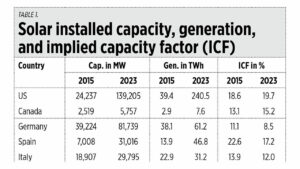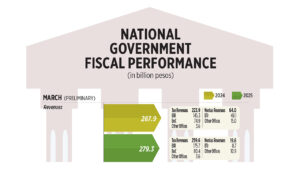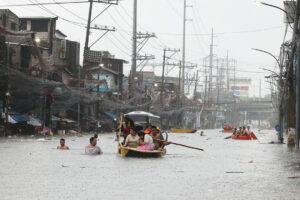Spain’s blackout and lessons for the Philippines

The big blackout that hit Spain, Portugal, and parts of southern France on April 28 starting 12:35 p.m. was a big blackeye to pushers of more intermittent renewables in the electrical grid.
According to energy analyst Javier Blas’ data, at 12:30 p.m. of April 28, Spain’s generation mix was: solar (photovoltaic and thermal) 65.8%, wind 12%, nuclear 11.6%, cogeneration and waste 4.7%, and gas combined cycle 3.4%, likely working as an ancillary service. Coal is zero because the socialist government of Spain shut down the last coal plant in 2024. So intermittent solar-wind was providing nearly 78% of the power just five minutes before the blackout. Even with batteries, these technologies do not have the inertia needed to keep the electricity flowing, unlike turbines powered by thermal fossil fuels and nuclear at significant levels.
Many Europeans are engrossed with solar power, even if their capacity factor — or the percentage of actual generation compared to stated and installed capacity — is very low, usually between 8% to 17% only. Meaning if they put up a 1,000-megawatt (MW) solar plant, it can generate only 80 to 170 MW on average (with zero output at night, and low output at daytime when it is cloudy, raining, or snowing).
I computed the implied capacity factor (ICF) of solar using a simple formula, ICF % = MWH/(installed capacity in MW x 24 hours/day x 365 days/year x 100). In 2023, solar-enthralled Germany and Spain had an ICF of only 8.5% and 17.2%, respectively. Globally the average ICF is only 13% (see Table 1).
In 2023, wind-mesmerized Germany, Spain, and the UK had wind/total generation shares of 27.7%, 22.8%, and 28.7%, respectively. France, the most nuclear-intensive country in the world (providing up to 80% of its total power few years ago) is the largest electricity exporter in Europe. The UK has an outlier situation: as it adds more wind and solar, its total power generation declines.
In contrast, Asian nations like China and Vietnam that use lots of coal power have consistently rising total power generation (see Table 2).
The numbers for the UK are released quarterly, so to make it consistent, I got the average per month for the highest and lowest quarterly data.
LESSONS FOR THE PHILIPPINESI saw a LinkedIn post by Meralco Power Gen (MGEN) President and CEO Emmanuel V. Rubio. I agree with what he wrote that “The Philippines cannot afford situations where power is unavailable. That’s why we must continue investing on a well-designed portfolio of new power plants to meet current demand with the right amount of reserves. We should also modernize and strengthen our energy transmission and distribution infrastructures to cope with the variability of current renewable energy technologies. On top of these are regulations, programs, and policies to encourage investments in energy infrastructure. The most expensive electricity is no electricity at all.”
Talking about transmission infrastructure, I saw an infographic from the National Grid Corp. of the Philippines (NGCP) showing that in 2025, they have available and excess transmission capacity of 3,330 MW in Luzon, 2,372 MW in the Visayas, and 1,120 MW in Mindanao, for a total of 10,260 MW nationwide. So, they are inviting power generators to connect to their facilities. This is the good news.
The bad news is that many proposed and incoming generation capacities are situated far away from the existing transmission infrastructure.
To help avoid a humiliating nationwide blackout like that of Spain and Portugal, is to use hydro pumped storage technology as an ancillary service in the grid. When I was in China last month, among the things I saw aside from many road and rail tunnels under many hills and mountains — was the Fengning pumped hydro storage plant in Hebei province, owned by the State Grid Corp. of China (SGCC).
It is the biggest pumped storage plant in the world at 3,600 MW (300 MW x 12 units). It was finished only last year. It uses beautiful physics and engineering theory, pumping the water down to the turbines when they need extra electricity, then pumping the water up for storage and later use.
Water from rivers is stored thrice — first in the Upper Reservoir, with a capacity of 45 million cubic meters (mcm); then the Lower Reservoir, with a capacity of 72 mcm; and finally in another reservoir with nearly 14 mcm. So, the three reservoirs have a total capacity of 131 mcm, each with a dam crest elevation of 1,066 to 1,510 meters, and they can generate 3,600 MW of electricity.
Our Angat Dam has around a capacity of 850 mcm and a hydroelectric capacity of only 246 MW. Angat is used mainly for potable water in Metro Manila and surrounding provinces. But there is no conflict between hydroelectricity use and potable water use because the water from hydro plants goes back to the river after moving the turbines, for potable and irrigation water use.
One possibility is for the Maharlika Investment Corp. (MIC) to partner with generation companies with existing expertise in hydro power plants, like Aboitiz Power and San Miguel Global Power, to put up pumped hydro storage plants of several hundred MW capacity upstream of Angat. The transmission capex will not be big because there is an existing transmission line in the hydro plant. Right of way troubles can be minimized because MIC has political muscle, being a government corporation, and it has recently invested in the NGCP via board seats at the Synergy Grid and Development Philippines (SGP).
Blackouts are ugly, uncomfortable, costly, and so Third World. Even frequent one-minute blackouts can damage appliances and bulbs. Abundant electricity supply, energy security — we should have them always.
Bienvenido S. Oplas, Jr. is the president of Bienvenido S. Oplas, Jr. Research Consultancy Services, and Minimal Government Thinkers. He is an international fellow of the Tholos Foundation.




